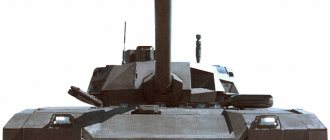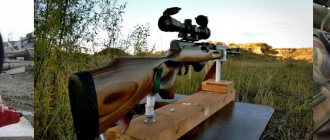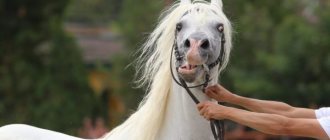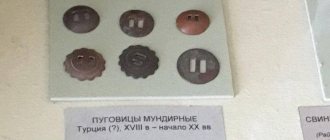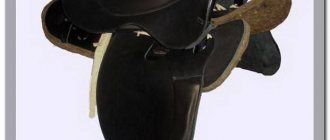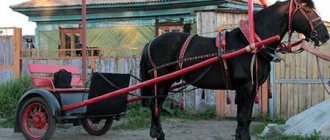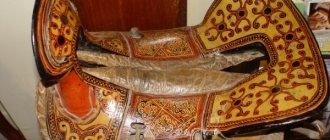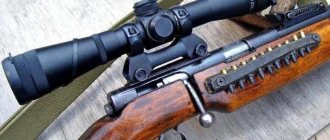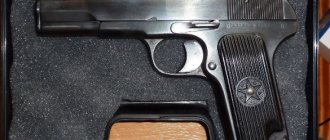Horse harness bears the load of the crew, so its correct selection and fit is very important for maintaining the health and performance of the horse. The harness consists of leather straps designed to distribute the load evenly. A harness is a fastening and traction system for a carriage, and equipment for riding horses is usually called a harness. The harness straps of a horse-drawn horse must be strong and soft.
Previously, no expense was spared on horse harnesses. As a rule, the production of harnesses was carried out according to individual orders, so the belts were ideally adjusted to a specific animal. Nowadays you can buy ready-made harness, but most often it turns out that not all parts fit the horse. People who work with horses prefer to buy all their parts from different places. The kit consists of a list of standard elements, which are listed below. Only the leather parts should be attached to the horse's body.
Basic set of harness for carriage and riding
What is horse harness
For a comfortable ride and convenient control, special devices for horses have been invented. Some of them help the horse cope better with the load. A set of such devices is called harness or ammunition. This equipment is intended for riding or working a horse in a harness.
The harness has been known since at least the 2nd century BC. The status of the animal's owner was recognized by its quality and design. Although, as a rule, ammunition was required only for convenience in work. Around the middle of the 16th century, beautiful horse harnesses became a fashionable attribute.
The equipment must be suitable for the specific horse. In the past, equipment was often made to order. Today in stores there is a choice for every taste.
What does horse harness consist of?
To transport goods and people in carts, a team is used. The set of harnesses is not always the same. Some parts are taken constantly, others only in certain cases. The composition of the harness depends on the purpose and method of harnessing.
Horse harness includes the following devices:
- Bridle. It consists of several elements - belts, usually leather. One goes below the chin. The headband consists of an occipital strap and one that runs in front of the ears. The harness, as a separate element or part of the bridle, includes a bit. This is a rod (gnawed) with rings on the sides. It is inserted into the edges of the mouth - where there are no teeth. The bit puts pressure on the tongue, lips, jaw and serves for control. The snaffle is often made of metal.
- Clamp . Connects horse and cart, transmits force and absorbs shock. It consists of two halves connected at the top - pliers, usually wooden. The bottom is tied with soup. There is a special lining under the clamp. The whole thing weighs 6–9 kg.
- A harness is a set of belts that secures the collar during sudden movements, for example, when stopping. A circular belt is placed on the horse's body. It is connected to pincers. The back strap is attached along the body, the side ones are located in the shaft area. Transverse and slope insure the main body belts.
- Shafts. These are guides - two thin sticks or tubes on the sides. They connect the cart and the clamp and transmit force. One shaft is called a drawbar; it is placed between the horses.
- Arc . Connects the shafts and the clamp. Softens the ride and prevents ticks from putting too much pressure on the animal’s neck.
- Gouges are belt loops. They are located near the arc and also combine shafts and a clamp.
- Saddle. This element of the horse harness secures the shafts and arc. Removes part of the load from the neck and transfers it to the back.
- A girth is a leather or synthetic belt with fastenings. Attaches the saddle. Modern models are suitable for a specific horse and are equipped with a lining.
- Cross-saddle , which also transmits the power of the horse, relieves the neck and shoulders. Fixes shafts, clamp. After the saddle, the ends are connected to the shafts.
- The underbelly is another strap. Needed for protection against impacts with a clamp or arc. Located on the stomach, slightly below the girth. It is connected to the interlace with a ring. They are mounted on shafts.
- Bib. This is an alternative to a clamp. Double-layer leather belt with rings. There are traces on both sides. The size of the bib is adjusted with buckles.
- Tracks. These are special belts or ropes. Transmits force from the clamp. The lines are connected to the front of the cart (waggon). This is done using rollers - bars, approximately 8 cm long. Each is equipped with two hooks. They put strings (loops) on them. The roller itself is attached to the vaga using a special clip.
- The rapist. Another belt passing to the drawbar from the bib. Holds when moving downhill.
- Reins are special thin straps, usually made of leather. Small and light straps are attached to the rings on the bit and tug. For control, the main thing is the bridle and reins, which are complemented by a whip and voice. The reins are used to encourage the horse: they lightly hit the croup. They should not be confused with riding reins.
Excerpt characterizing Harness
“Tomorrow our squadron is assigned to reserves; Let me ask you to second me to the 1st squadron. - What's your last name? - Count Rostov. - Oh good. Remain with me as an orderly. – Ilya Andreich’s son? - said Dolgorukov. But Rostov did not answer him. - So I will hope, Your Excellency. - I will order. “Tomorrow, perhaps, they will send some kind of order to the sovereign,” he thought. - God bless". The screams and fires in the enemy army occurred because while Napoleon's order was being read among the troops, the emperor himself was riding around his bivouacs on horseback. The soldiers, seeing the emperor, lit bunches of straw and shouted: vive l'empereur! ran after him. Napoleon's order was as follows: “Soldiers! The Russian army comes out against you to avenge the Austrian, Ulm army. These are the same battalions that you defeated at Gollabrunn and which you have since constantly pursued to this place. The positions we occupy are powerful, and while they move to flank me on the right, they will expose my flank! Soldiers! I myself will lead your battalions. I will stay far from the fire if you, with your usual courage, bring disorder and confusion into the enemy’s ranks; but if victory is in doubt for even one minute, you will see your emperor exposed to the first blows of the enemy, because there can be no doubt in victory, especially on a day in which the honor of the French infantry, which is so necessary for the honor of his nation, is at issue. Under the pretext of removing the wounded, do not upset the ranks! Let everyone be fully imbued with the thought that it is necessary to defeat these mercenaries of England, inspired by such hatred against our nation. This victory will end our campaign, and we can return to winter quarters, where new French troops that are forming in France will find us; and then the peace that I will make will be worthy of my people, you and me. Napoleon." At 5 o'clock in the morning it was still completely dark. The troops of the center, reserves and Bagration’s right flank still stood motionless; but on the left flank the columns of infantry, cavalry and artillery, which were supposed to be the first to descend from the heights in order to attack the French right flank and throw it back, according to disposition, into the Bohemian Mountains, had already begun to stir and began to rise from their overnight positions. The smoke from the fires into which they threw everything unnecessary ate my eyes. It was cold and dark. The officers hurriedly drank tea and had breakfast, the soldiers chewed crackers, beat a shot with their feet, warming up, and flocked against the fires, throwing into the firewood the remains of booths, chairs, tables, wheels, tubs, everything unnecessary that could not be taken with them. Austrian column leaders scurried between the Russian troops and served as harbingers of the attack. As soon as an Austrian officer appeared near the regimental commander’s camp, the regiment began to move: the soldiers ran from the fires, hid tubes in their boots, bags in the carts, dismantled their guns and lined up. The officers buttoned up, put on their swords and knapsacks and walked around the ranks, shouting; The wagon trains and orderlies harnessed, packed and tied up the carts. Adjutants, battalion and regimental commanders sat on horseback, crossed themselves, gave the last orders, instructions and instructions to the remaining convoys, and the monotonous tramp of a thousand feet sounded. The columns moved, not knowing where and not seeing from the people around them, from the smoke and from the increasing fog, either the area from which they were leaving or the one into which they were entering. A soldier on the move is as surrounded, limited and drawn by his regiment as a sailor by the ship on which he is located. No matter how far he goes, no matter what strange, unknown and dangerous latitudes he enters, around him - as for a sailor, there are always and everywhere the same decks, masts, ropes of his ship - always and everywhere the same comrades, the same rows, the same sergeant major Ivan Mitrich, the same company dog Zhuchka, the same superiors. A soldier rarely wants to know the latitudes in which his entire ship is located; but on the day of battle, God knows how and from where, in the moral world of the army, one stern note is heard for everyone, which sounds like the approach of something decisive and solemn and arouses them to an unusual curiosity. During the days of battle, soldiers excitedly try to get out of the interests of their regiment, listen, look closely and eagerly ask about what is happening around them.
Types of harness
There are different types of horse equipment designed for different numbers of horses. The choice depends on the goals:
- Transport harness - needed when there are several animals in the harness.
- Agricultural - intended for one or two horses.
- Traveling - needed for entertainment, festivities. This horse harness is designed for a different number of horses.
Single-horse
The harness for the only animal in the harness has a standard set: bridle, reins, horse collar, etc. In single-horse ammunition, sometimes there are options without an arc. In this case, the main element on which the cart is supported is the harness. She bears the brunt.
The harness used here is a shaft-arc harness. This type is also called Russian. In Europe it is almost never used.
In a single-horse Russian harness, lines are also used. In this case, short shafts are often used. They are attached not to the clamp, but to the saddle.
Tachanochnaya
Four horses are rare today. At the beginning of the last century they were popular. For military purposes they used carts - carts with springs and a heavy machine gun. Cart ammunition was not always designed for four horses. Sometimes there were two or three of them in a team.
The harness included lines and a drawbar. A pair of horses were attached on either side of a single shaft. The remaining side animals were fastened to the lines attached to the vags. The carts had a high speed of movement.
On the monument in the Rostov region in honor of the 1st Cavalry Army, the reins and spokes of the wheels are not visible. There is no mistake by the sculptors here - at speed these details were not noticeable. The cart harness was comfortable and perfect for war.
Line-by-line-drawbar
This type contains the same elements as the cart type. A drawbar harness is needed when using a cart. As a rule, there are two horses. This equipment is convenient:
- provides relative safety, for example, on steep slopes;
- the performance of horses is increasing.
The harness must be put on correctly. If you tighten the fastenings too much, the structure will warp. Sometimes horses get injured due to the drawbar pressing on the collar. It is important to tighten the straps, including the seat belt.
Line by line
There is a type of harness without an arc and a shaft. It is used in track harness. The harness is simple and is often used, including in agriculture. The horsepower here is transmitted by the lines and clamp.
Such harnesses are not always convenient to use, and sometimes even dangerous. When moving in a straight line, the cart may not be able to hold on downhill. Animals get injured, and this also promises problems for the owners. Experts recommend upgrading your equipment - getting brakes.
One of the advantages of such equipment is its low weight, which makes the horse’s work easier.
Line harness is used for carts, including carriages. Farmers use such harness to harness their horses to a plow and harrow. In agriculture, the horse makes a lot of effort, so the risk of running over and injury is less.
Combined
There are harnesses for the European method of harnessing. It is called combined. The ammunition includes shafts and a drawbar with lines. They carefully select equipment for each of the animals, and there are 6–8 of them here. Horses must be of suitable height and approximately the same strength
It is especially important to equip the root dogs - the tallest and strongest animals in the harness. Working alongside them are the tie-downs, who are attached with lines. These horses are responsible for turning. The direction is determined by the outriggers. They are also fastened with straps.
Zug
There is also harness for other rare harnessing methods. These include, for example, the zug, invented in Germany. As a rule, horses of the same color were harnessed in this way. Today the zug is found almost nowhere. He can be seen on film sets, walks or historical shows.
The zug resembles the line-and-drawbar harnessing method. Horses walk one after another (in single file) or in pairs. The train was abandoned, mainly because the horses move slowly.
The harness set is designed for 6 or 8 animals, 4 of which are external. When harnessing, use a drawbar. A pair of root rods are attached to it.
Harness configuration options
- Line-and-drawbar harness is used for one and two horses. Its main task is to ensure controlled movement of the cart on turns and descents. The holding function is performed by the drawbar. Very often, when pulling agricultural machinery, animals receive specific injuries from the harness due to the pressure of the drawbar on the clamp. To prevent this, you need to put a saddle on the horse, tightening the lines with the help of a loafer. Then the performance of horses will increase impressively;
- A line-by-line harness is the simplest option in design, but it is inconvenient, since during descents the cart does not slow down and bumps into the horse. It does not have a drawbar, shaft or other holding mechanisms. Such a harness can only be used for those carts and units that are equipped with brakes, otherwise you can harm the horse;
- Carts were actively used until the 20th century. They were harnessed by four horses. The harness consisted of a drawbar combined with lines. At the same time, two horses in the center were harnessed to a drawbar, and two attached horses were harnessed to lines that were attached to the wags;
- A combined harness is designed for a large number of horses. The troika is harnessed according to this principle. The root rod is harnessed to the elements that restrain the crew, and the fastening ones are only harnessed to the lines to provide traction force. The task of the hitches is to ensure that the cart turns. In this way you can harness 6 – 8 horses.
Classic multi-horse harness for three
Selection of team
Preferences in horse tack vary from country to country. In Russia, the shaft-arc harness is more common.
Harness is selected depending on the number of animals. There are, for example, the following options:
- Tandem - two horses one after the other.
- Three horses - harnessed single file, Russian troika.
- Four - cart type or in pairs.
More than six horses are used only for external effect.
Sometimes they buy a ready-made set of harnesses for teams. However, professionals recommend carefully selecting each piece of equipment separately.
The stronger and lighter the horse harness, the better. Modern ammunition is constantly being improved. Often it is made from new, non-traditional materials. Such products are easier to use, put on and wash.
Each part has standard requirements:
- Saddle shape and size. For high withers, standing is suitable; for low withers, lying down. This is important for the performance and health of the horse.
- You cannot make a mistake with the size or type of bit, otherwise the animal will constantly suffer . The device is made from different metals. Take as soft as possible. Today there are even plastic and rubber models for sensitive teeth.
Elements of riding horse harness
The cavalry army previously greatly influenced the formation of harness, so here we will consider not only elements of modern horse equipment, but also items of historical harness for military horses:
- A bridle with a bit is the main element of horse control. The design includes several belts: crest, forehead, cheek, chin, muzzle. A bit with two rings, a bit and reins with a lanyard are attached to them. Common types of bits: snaffle, mouthpiece, pelam;
- Snaffle - consists of a bit and two rings. The snaffle is attached to the cheek straps of the bridle using rings;
- The mouthpiece is a bit with specific side “cheeks” that have an enhanced effect on the animal’s mouth. The mouthpieces are reinforced with a chain that is fastened to the hooks so as to cover the horse's lower jaw. Used in dressage riding for fine control of the horse;
- Pelyam is the same mouthpiece, but equipped with a movable bit. The effect on the horse's mouth is weaker than a mouthpiece, but stronger than a snaffle;
- For peasants, travelers and the cavalry regiment, the health and performance of horses was very important, so they were covered with blankets at night. Winter blankets are made of fleece or wool with padding polyester lining. Summer blankets are made of cotton, mesh (against flies);
- A saddle pad (cover under a saddle) is a historical element of horse regiments. Its purpose is to protect the horses' backs from damage from the saddle. In addition, in Russia it was used as a decoration for horse harnesses. The officers flaunted their harness in front of each other, in addition, the color of the saddle pad differed depending on the color of the uniform;
- A girth is a wide strap made of soft but durable leather designed to hold the saddle. Covers the horse's body from below and from the sides, then fastens it to the saddle. The best girths are made of genuine leather;
- Boots are protective equipment designed to protect a horse's legs from sprains and impacts;
- A halter is a bridle without a bit for keeping a horse on a leash;
- Stirrups are loops for the rider's legs attached to the saddle.
Main parts of the saddle and their names
How to make a horse collar with your own hands
Purchasing horse harnesses can be expensive or inconvenient. The available options are not always suitable. You can make some parts of the ammunition yourself, for example, a clamp.
There are several steps to make it:
- Find out the size of the horse's neck. Length - from the crest at the beginning of the withers to the shoulder blades, shoulder. The meter is applied to the base of the neck. Add another 4–6 mm to the numbers. The width is measured at the base, preferably with a Wilkens compass.
- Multi-layer plywood is suitable for ticks, the product from which is smaller, lighter and does not crack so quickly. Take three sheets of 5 mm plywood and glue them together with PVA. Dry.
- A drawing is applied to the plywood.
- Cut out parts, for example, with a jigsaw.
- They make a clamp - a lining located between the pincers and the horse's body. The covering is made of soft leather from 1 mm thick. It sits tightly on a rope, stuffing - a piece of flax, hay, straw. The “insides” of the clamps are wrapped with tape for tightness. Sew the covering.
- The clamp is fixed with pliers. Crosslinking is used. The ends of the clamps are nailed (25 cm) every 3 cm.
- A special pillow is made from a single piece of felt or similar material. Fold in several layers. The edges are folded and felt strands are applied. The two cushion bolsters require leather stitching. Valves are made in their center. They are made of leather measuring 10 by 6 cm. Then the pillow is quilted. The seam is approximately 1 cm.
- Attach the pillow to the pliers. Sew in at least three places. At the withers, slightly raised and leveled.
- The clamp cover is made from leather or a substitute. There will be 3-4 parts. Central - 30–40 cm, overlap - at least 1.5. They make cutouts for tugs.
- The tire is tightly put on the pliers and nailed down.
- Gouges are made from cow leather with a thickness of at least 0.5 cm. Sometimes they take nylon with a thickness of 4 cm.
- Thread the tugs into the holes of the tire. They nail it.
- They measure the clamp. It should fit snugly. A small one is rejected, a large one is narrowed down: felt is sewn inside.
Russian horse harness and its types
Harness - a set of items and devices for harnessing and saddling a horse. It is divided into harness and riding harness. The riding harness included the following items: bridle, saddle with stirrups, sweatshirt, saddle cloth, girth, chest and tail straps, and trench coats. The harness included a collar, a bow, a bridle, a halter, reins, a harness, a saddle, a girth, a saddle pad, a saddle cloth, and a saddle cloth.
In addition, it included other items used in double-horse or triple harnesses for harnessing horses: a collar, a harness, and lines. The composition of harness items has changed little throughout the history of the Russian people. This especially applies to a set of items for saddling a horse. In the XII-XVII centuries. it was the same as in the peasant economy of the 19th century. This is evidenced by archaeological finds, as well as images of horses under saddle in medieval icons and drawings.
The question of when the entire set of harness harness known to us from materials of the 18th-19th centuries was fully completed has not yet been finally resolved. The time of appearance of the arch and saddle still remains unclear. Some researchers believe that the arc appeared at the end of the 15th - beginning of the 16th centuries. Others believe that the arc was known at the beginning of the 12th century. However, during archaeological excavations in Veliky Novgorod, entire arcs are found only in layers of the 14th century.
As for the saddle, it is equally difficult to name the timing of its appearance. In the drawings of Russian horse harnesses with a bow, made in the first half of the 16th century. S. Herberstein, it is not marked. Most likely, the Middle Ages were characterized by a different way of controlling a horse harnessed to a cart: the driver sat astride the horse, and not on a harness, as was customary in the 18th-19th centuries. At the end of the XVI-XVII centuries. the saddle was probably already included in the harness. Evidence of this is the 17th century saddles kept in the Kremlin Armory.
Russian peasants attached great importance to the “horse outfit,” especially when traveling on holidays, to the city for a fair, or during a wedding ritual. The harness was elegantly decorated and people were proud of it. Festive harness, carefully preserved by the owners, was passed down from generation to generation as an eternal family treasure. Russian peasants even had a custom every year on the first day after Candlemas (February 3/16) to put their work and holiday harness in order. This day was called Pochinok in the folk calendar.
It began with the men inspecting the horses in the stable and appeasing the spirit of the courtyard - the courtyard, after which the whole family sat down at the table and ate salamat - a meal made from flour. “The salamata has arrived in the yard, start the repairs,” says the Russian proverb. This attitude towards expensive, beautiful festive harness goes back centuries, to Medieval Rus'. In Russian medieval cities, walking for an important person - a tsar, a boyar, a rich merchant - was considered reprehensible and even indecent. Every time he left the house he had to use a riding horse or a team of horses, even if the distance was very short.
For example, the English traveler A. Jenkinson wrote in the 16th century: “If a Russian has at least some means, he never leaves the house on foot, but in winter he goes on a sleigh, and in the summer he rides on horseback, in a sleigh he sits on a carpet or polar bear skin. The sleigh is pulled by a richly decorated horse with many fox and wolf tails around its neck; it is ruled by a boy sitting on a horse, servants stand at the back" {English Travellers. 1938, 80). Each departure was supposed to be arranged as a very solemn action, demonstrating the person’s wealth, his dignity and the high position that he occupied on the hierarchical ladder.
With this attitude, any wealthy and noble person tried to outdo the other with his travel. The horse harness was very magnificent. The bows of the saddles were covered with silver and gold plates with a stamped pattern, with niello, enamel, decorated with enamel, the saddle cushion, the saddle pads were made of expensive morocco with embossing, the velvet or satin saddle cloth was embroidered with gold and silk threads, and set with pearls. Particularly elegant were the saddle blankets that were thrown over the saddles during festive trips of rich people.
Bridles were assembled on a narrow belt or braid with gold or silver plates, covered with enamel, pearls, amber, corals and precious stones. The horse's nose bridge was decorated with reshmas - gold or silver plates with chased patterns, covered with emeralds, yachts, and diamonds. The driving chains were made especially beautiful, i.e. chains that ran from the bit along the reins to the front saddle pommel, and rattling chains that descended from the pommel to the sides of the horse. The driving chains were made from small silver plates with gilding, on which an ornament was engraved or minted, and the rattling chains were made from fairly large bells with silver balls inside.
When riding on horseback, they loved to hang tassels (nauzas) under the horse’s muzzle, which went down to the level of his chest. They consisted of gold plates with precious stones and silk or gold fringe. Nauzes decorated the horse and served as amulets. Horses participating in the ceremonial ride were often put on knee pads - wide silver hoops with gilding on a soft lining. They were attached to the horse's legs just above the fetlock joint. Foreign travelers left vivid memories of the ceremonial trips of Russian tsars and boyars, of the wealth and beauty of horse harnesses.
The Polish resident Svidersky, according to one of the Russian scribes, spoke with admiration about the departure of the Russian Tsar Alexei Mikhailovich to Trinity in 1675: “And how the Great Sovereign’s horses were led and the veils and the Polish resident were carried in front of them, seeing, greatly surprised , said: although it is possible to find such horses from the neighboring sovereigns, he expects that such horses’ outfit and decorations are so precious that none of the sovereigns can find them” (Monuments 1853, V, 230). The secretary of the Roman embassy, Adolf Lisek, described the departure of Tsar Alexei Mikhailovich to the Holy Trinity Sergius Monastery as follows: “The next train left us in amazement. The groom rode ahead, followed by 62 excellent horses, on which all the harness and blankets were burning in gold and silver” (Lizek 1837.37).
The harness for ceremonial rides was no less magnificent than the horse harness. The pincers of the collars were decorated with gilded carvings, decorated with fox and sable tails, the saddles, then called saddlery roofs, were covered with gold fabrics, velvet, and decorated with enamel plates with precious stones. The harnesses were made of leather or gold braid, covered with gold or silver plates also with precious stones.
Horse harness
A set of items for saddling a horse. The riding harness included: a bridle, a saddle with stirrups, a saddle cloth, a saddle cloth, a girth, a chest and undertail straps, and trench coats. Horse harnesses were less common on peasant farms than harnesses. In most of Russia, peasants preferred harnessing horses to riding horses. Russian peasants usually traveled to holiday celebrations, on visits, to the city to the fair in sleighs, carts, droshkys, and tarantasses.
Horses under saddle took part only as part of the wedding train, when the groom traveled to pick up the bride for the wedding: they were ridden by the groomsmen and friends - the main celebrants of the wedding on the part of the groom. In addition, in some villages on Maslenitsa horse races were held, during which young men and boys showed their prowess and youth. The only exceptions were the Cossacks, for whom the horse was a necessary part of military equipment, and the Russians of Altai and Siberia, where horse riding was widespread due to the lack of good roads, forests and mountain slopes often impassable for draft horses. For Cossacks, riding was as typical as riding in a cart or sleigh for other Russians, and a good horse is a man’s main joy and pride. In an old song of the Ural Cossacks, a father punishes his son:
And a good horse is all our happiness, He is the honor and glory of the Cossack. He is needed in happiness and misfortune, both for the enemy and against the enemy. A war horse is more valuable than anything else... And you, my son, treasure it; And you’d better eat better yourself, keep the horse in your body.
The Cossacks tried to purchase richly decorated harness for saddling a horse, since all the amusements of boys and adult men in Cossack villages included demonstrating themselves on a horse and a horse in expensive harness. On patronal, cherished and village holidays, Maslenitsa, Yegoryev's Day (April 23/May 6) they organized horse racing, horseback riding, and horseback riding around the village. Everyone watched the young Cossacks with interest, approvingly appreciating their ability to sit beautifully in a smart saddle and control a horse.
Russians of Altai and Siberia also sought to purchase horse harnesses for their homes. It was necessary for traveling to a neighboring village and for transporting goods on horseback. In addition, in many villages it was customary to ride a horse on holidays. For example, among the Russians of Transbaikalia, festive riding of girls on horseback was common. In the southern, mountainous regions of the Tobol region, the bride and groom rode on horseback, even down the aisle. The horse harness was decorated in the same way as the harness (see Harness). The saddle was made of expensive leather, and its bows were decorated with wide metal plates. They tried to make the stirrups, bridle, and saddle cloth beautiful.
Harness or harness
A set of items and devices for harnessing horses to a cart. It included the following items: a collar, a bow, a bridle, a halter, reins, a harness, a saddle, a girth, a saddle pad, a saddle cloth, and a saddle cloth. In addition, it included items used in two-horse or three-horse carts for harnessing tethered horses: a collar, a shorka, and lines. Harness was available in every peasant household in a festive and everyday version. Everyday harness was inexpensive for the peasant, since it was usually made from fairly cheap materials, such as hemp braid, ropes, rough leather, etc.
Many of the items included in it could be made by yourself: reins, halter, harness, girth, saddlebag, lines. They were woven or weaved by women and crafted by the owner of the house. The working harness was good quality, strong, but not necessarily beautiful. Beauty, along with good quality, was considered a necessary feature of the festive harness. The beautiful festive harness worn by traveling stallions was a sign not only of the wealth of the peasant family, but also a sign of dignity, self-respect, and hard work. Festive harnesses were usually made from strong rawhide belts, beautiful, high-quality leather, good wood species and had a large number of decorations.
The peasant first of all dreamed of buying an elegant arch for a holiday trip with his family, because... in the harness it was especially noticeable. The arcs were extremely elegant in the northern provinces of European Russia, as well as in Kostroma and Nizhny Novgorod. They were decorated with carvings and paintings. The painted arcs, as a rule, had a floral pattern: garlands of red and white flowers, reminiscent of roses or rose hips, green leaves, and yellow berries, were painted on a golden-yellow background. In some areas, it was customary to paint on a golden background using bright red or blue paint. Her motifs were flowers, herbs, and grapes.
The arc cones often depicted lions and leopards standing on their hind legs. On arches decorated with carvings, the ornament was predominantly geometric, composed of cartouches, rosettes, and rhombuses, but there were also plant motifs, such as trefoils, made in a geometric style. Many arcs, especially valued by craftsmen and owners, had inscriptions. Usually the inscription followed the curve of the arc and contained information about its owner, the date of manufacture, and the name of the artist who decorated the arc. So, on one arc from a village on the Northern Dvina it was written: “1877 Year of Kurgaminsky rights. Zaostrovskaya hair. Dere. Lamkoskoy Kres. Akila Petrova Zykova.”
The collar was decorated even more diversely than the arc: it was covered with carvings and paintings, leather embossing, as well as a metal device (set), i.e. plates, round plaques, and on ancient clamps - plates with images of riders, horses, birds. The painting almost always had a floral motif, and the carving consisted of nail-like or triangular recesses located in bands along their edges. Embossing was applied to the skin with special stamps, which left rosettes, circles, crosses, squares, and corners on it.
The harness, saddle cover, bridle, and shorka were most often decorated with the so-called metal device. It consisted of cast plates of various configurations, attached to the skin with pegs, and pucoles - round decorative heads on two extendable legs, which were inserted into the skin. Metal jewelry was cast from copper, green copper - an alloy of copper and zinc in a ratio of 70% to 30%, tombac - an alloy of copper and zinc, but in a different proportion - 85% to 15%, Polish silver, i.e. an alloy of copper and nickel, and also stamped. The plates were of different colors: white, yellow, black, of various shapes, most often geometric, and each had its own name: plaque, bow, pea, rosette, circle, thing, verb, trifle, etc.
On the same object one could see devices made up of many variants of plates. Moreover, each item included in the harness was assigned its own set of cast or stamped decorations. Pucols and plates on pegs were attached to the saddle cover and harness straps. Shorka, along with pucols and plates, was covered with rosettes, plaques, caps, i.e. crosses. The connection of the harnesses and bridles was decorated with so-called places, i.e. rectangles, diamonds, circles, ovals.
In addition to the metal set, harnesses and bridles were decorated with tassels made of leather, garus, and metal. The headbands of the bridle were intertwined with thin red and green straps, and a plume made of leather or other materials was fastened between the horse's ears. The festiveness of the harness was also given by bells and bells, which were attached to the bow, collar, and saddle. The elegant festive harness evoked sincere admiration among those gathered for the festivities. Russian poet I.S. Nikitin wrote in 1855:
Listen, wife! Look at the bridles! Look, like a copper set. Here are terry, rings. And the arc, the arc, shines in gold...
Material created: 10/22/2015
Single shaft, plow or shuttle
Saddle or harness
How to harness a horse
The harness must be put on correctly. The preparatory stage includes the following actions:
- Checking the ammunition. Replace and repair if required.
- They check the cart.
- Examine the animal.
The order depends on the number of horses in the team and the type. For shaft-arc, do the following:
- They put on a bridle. In winter the bits are kept warm.
- Throw a saddle with a saddle over the back next to the withers. They move. The back of the saddle ends up around the horse's 9th to 15th rib. The harness is 10 cm from the animal’s elbow.
- They put on a girth.
- Turn the clamp upside down. They put it on. In a narrow area, they turn it over again.
- I put a harness on the body.
- Then they lead us into the shafts. Both sides are connected to the stringer. Use saddle loops.
- Place an arc under the left shaft. Move counterclockwise onto the clamp.
- The same is done on the other side.
- The clamp is tied with supony.
- The reins are passed through the middle of the arc, sometimes from the outside.
- They look at the work, the location of the shaft, clamp and the rest. The tug should be behind the arc.
- They try it slowly while moving.
It is important for a horse owner to be familiar with horse equipment and be able to handle it. The right choice helps in work and protects the health of animals.
